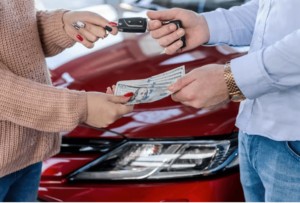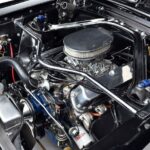Discovering a car ding can be a minor annoyance or a major headache, depending on its severity and your budget. If you’ve just noticed an unwelcome dent on your vehicle, you’re likely wondering: “How much to repair car ding?” This comprehensive guide will break down the costs associated with car ding repair, helping you understand the factors involved and explore your repair options. Equip yourself with the knowledge to make informed decisions and get your car looking its best again without breaking the bank.
Understanding Car Ding Repair Costs: An Overview
 Car Dent Repair Cost
Car Dent Repair Cost
The average cost to repair a car ding can vary significantly, generally falling between $50 and $2,000. This broad range is influenced by several key elements, including the size and type of the ding, the chosen repair method, and whether repainting is necessary.
To give you a clearer picture, here’s a detailed breakdown of common repair types and their typical costs:
| Repair Type | Average Cost | Type of Dent | Example Scenario |
|---|---|---|---|
| Paintless Dent Removal (PDR) | $50–$300 | Minor dings, small dents without paint damage | A door ding from a neighboring car in a parking lot, or shallow hail damage. |
| Minor Dent Repair with Paint | $200–$750 | Medium-sized dents requiring slight bodywork and paint touch-up | A dent from a shopping cart causing minor paint scratches, or a shallow dent on a fender. |
| Major Dent Repair with Paint | $750–$3,000+ | Significant dents involving panel reshaping, filling, and repainting | Damage from a low-speed collision requiring body filler and blending paint across panels. |
| Car Door Ding Repair | $75–$600 | Dings specifically on car doors, ranging from shallow to more noticeable | Scratches and dents from opening doors too wide in tight spaces, or impacts from road debris. |
| Hail Damage Repair (PDR) | $150–$1,500+ | Multiple small, round dents across the vehicle’s panels | Damage from a hailstorm, with costs escalating based on the number and size of dents. |
| Minor Collision Ding Repair | $300–$1,200 | Dents resulting from low-impact accidents or fender benders | Dents and minor panel distortion from parking lot incidents or bumping into objects. |
| Bumper Ding Repair | $350–$2,500 | Dents, scrapes, or cracks on plastic or painted bumpers | Damage from minor impacts, requiring bumper repair or even replacement depending on severity. |
| Crease Dent Repair | $250–$2,000 | Sharp, linear dents that are more complex to repair | Dents along body lines or edges, often requiring specialized PDR techniques or traditional methods. |
For smaller, less severe dings where the paint is undamaged, Paintless Dent Removal (PDR) offers a cost-effective solution, typically ranging from $50 to $300. Conversely, larger or more intricate dents, especially those with paint damage or located in challenging areas, will necessitate traditional repair methods involving bodywork and repainting, leading to costs from $200 up to $3,000 or even higher for extensive damage.
Paintless Dent Removal (PDR) vs. Traditional Repair Methods
When addressing car dings, understanding the difference between Paintless Dent Removal (PDR) and traditional repair methods is crucial for both cost and quality considerations. The best approach depends largely on the nature and extent of the damage.
PDR Explained
Paintless Dent Removal (PDR) is a specialized technique used to repair minor dents and dings without affecting the vehicle’s factory paint job. Skilled technicians use specialized tools to gently massage and manipulate the metal from behind the panel, effectively “pushing” the dent out and restoring the panel to its original shape.
PDR is ideal for:
- Small to medium-sized dings: Typically up to a few inches in diameter.
- Shallow dents: Dents that are not too deep or sharp.
- No paint damage: Crucially, PDR works best when the paint surface is intact and not cracked or scratched.
Traditional Repair Explained
Traditional dent repair methods are employed when the damage is more severe, involving significant dents, creases, or paint damage. This process typically involves:
- Sanding: Grinding down the damaged area to remove paint and smooth out imperfections.
- Body Filler Application: Applying filler material to reshape the dented area and create a smooth surface.
- Sanding and Shaping: Sanding the filler to match the original body contours and ensure a seamless repair.
- Priming: Applying primer to create a base for painting and ensure paint adhesion.
- Painting: Repainting the repaired area to match the vehicle’s original color, often requiring blending into adjacent panels for a perfect match.
- Clear Coating and Polishing: Applying a clear coat for protection and shine, followed by polishing to achieve a flawless finish.
PDR vs. Traditional Repair: A Comparative Overview
| Category | Paintless Dent Removal (PDR) | Traditional Dent Repair |
|---|---|---|
| Average Cost | $50–$500 | $200–$3,000+ |
| Time to Repair | Typically a few hours, often same-day service | 1–5 days, depending on damage complexity |
| Best for | Minor dings, shallow dents, no paint damage | Larger dents, deep creases, paint damage, structural damage |
| Paint Integrity | Preserves original factory paint | Requires sanding and repainting |
| Vehicle Value | Helps maintain vehicle’s original value | Repainting may slightly affect perceived value if not expertly done |
| Environmental Impact | Eco-friendly, minimal waste, no chemicals or paint | Higher environmental impact due to paint, solvents, and materials |
Choosing between PDR and traditional repair hinges on the dent’s characteristics and your priorities. PDR is often quicker, more affordable, and preserves your car’s original paint, making it ideal for minor dings. Traditional repair is necessary for more extensive damage, ensuring structural integrity and a flawless finish when paintwork is involved.
Key Factors Influencing Car Ding Repair Costs
Several factors contribute to the final cost of car ding repair. Understanding these elements will help you interpret estimates and make informed decisions.
-
Size and Depth of the Ding: Smaller, shallower dings are inherently less expensive to repair. They require less time, simpler tools, and often qualify for PDR, which is generally cheaper. Larger or deeper dents demand more extensive work, potentially involving traditional repair methods, increasing both labor and material costs.
-
Location of the Dent on the Vehicle: Dings in easily accessible, flat panels are simpler and cheaper to fix. However, dents located on complex curves, body lines, or edges require more specialized skills and time, pushing up labor costs. Dents in hard-to-reach areas may necessitate partial disassembly of vehicle components, further increasing labor charges.
-
Type of Vehicle (Make and Model): Luxury vehicles and cars with specialized body materials like aluminum or carbon fiber often require technicians with specific expertise and tools. Repairing these vehicles can be more costly due to the specialized knowledge and equipment needed. Even common vehicle makes can have variations in panel construction that affect repair complexity.
-
Presence and Severity of Paint Damage: If the car ding has scratched, chipped, or cracked the paint, the repair cost will increase significantly. Addressing paint damage involves additional steps like sanding, priming, color matching, repainting, and clear coating. The cost escalates further if blending paint into adjacent panels is necessary to ensure a seamless finish.
-
Chosen Repair Method (PDR vs. Traditional): As discussed, PDR is generally less expensive than traditional repair. Opting for PDR when appropriate can result in considerable savings. However, the nature of the dent dictates the suitable method, and attempting PDR on damage requiring traditional repair can lead to unsatisfactory results or further complications.
-
Labor Rates and Shop Location: Labor costs vary significantly between repair shops and geographic locations. Dealership body shops often have higher labor rates compared to independent repair facilities. Urban areas or regions with a higher cost of living may also have inflated labor costs. Obtaining quotes from multiple shops in your area is crucial to find competitive pricing.
6 Smart Ways to Save Money on Car Ding Repair
Keeping car repair costs down is a priority for most vehicle owners. Here are practical strategies to save money without compromising the quality of your car ding repair:
-
Obtain Multiple Estimates from Different Repair Shops: Pricing for car ding repair can vary substantially between body shops, dealerships, and independent PDR specialists. Contact at least three different repair providers to get detailed estimates. Compare these quotes, paying attention to the breakdown of costs for labor and materials.
-
Assess the Dent’s Location and Size Realistically: Understand that minor, easily accessible dings are inherently cheaper to fix. When discussing repairs with shops, be prepared to provide accurate details about the dent’s size, location, and any paint damage. This helps in getting more precise estimates and potentially negotiating better prices for simpler repairs.
-
Consider DIY Repair for Very Minor Dings (with Caution): For extremely small, shallow dings where the paint is absolutely intact, DIY dent removal kits are available. However, proceed with caution. Improper use of DIY kits can worsen the dent or damage the paint, leading to more costly professional repairs. DIY is only advisable if you are confident and the damage is truly minimal.
-
Evaluate Your Car Insurance Coverage Wisely: Review your car insurance policy to understand your coverage for collision damage and your deductible. For larger, more costly dents, filing an insurance claim might be beneficial, especially if the damage was caused by another party. However, consider your deductible and potential premium increases before filing a claim for minor damage.
-
Inquire About Warranties and Guarantees: Choose repair shops that offer warranties on their workmanship. A warranty provides peace of mind, ensuring that if any issues arise with the repair, you are covered. Shops confident in their quality are more likely to stand behind their repairs, potentially saving you money on rework in the future.
-
Build a Relationship with a Local, Reputable Body Shop: Establishing a relationship with a trusted local auto body repair service can be advantageous in the long run. Regular customers may receive preferential treatment or discounts. Moreover, a reputable shop is more likely to provide honest assessments, quality repairs, and maintain your vehicle’s value.
Summing Up
Dealing with car dings doesn’t have to be a stressful or financially draining experience. By understanding the factors that influence repair costs and exploring various repair options like Paintless Dent Removal and traditional methods, you can approach car ding repair with confidence and make informed decisions. Remember to obtain multiple quotes, assess the damage accurately, and consider cost-saving strategies to manage expenses effectively. While DIY solutions might be tempting for minor issues, professional repair often provides the best long-term value, ensuring quality workmanship and preserving your vehicle’s appearance and resale value. Don’t hesitate to reach out to reputable repair professionals for detailed assessments and quotes tailored to your specific “how much to repair car ding” needs.
Visit StormWise for Professional Car Dent Repair Services

